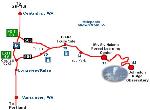| MountStHelens.com Information Resource Center |
| Mount St. Helens National Park * |
Mt. St. Helens National Park is located in Washington State off I-5 approximately
2.5 hours south of Seattle and 1.5 hours north of Portland. It is visited by more than 500,000
visitors a year. The majority of the visitors enter the Mount St. Helens National Park from
Highway 504 on the west side which holds the two main visitor centers: Johnston Ridge
Observatory ($8/adult) at milepost 52, and the Forest Learning Center (Free) at milepost
33. Travelers from Seattle should take exit 63 through Toledo and those from Portland can
take exit 49, Castle Rock.
Volcano-watching and photographing America's volcano is the top past-time at the National
Park followed by touring the exhibits and movies at these two Main Mount St. Helens National
Park Visitor Centers. Other Popular Mount St. Helens National Park Activities include:
The Mt. St. Helens National Park has a secondary viewing area at Windy Ridge accessed
from the north side of the park off Highway 12 near Randle via highway 25 / 99. Lacking any
amenities this is a winding road with steep drop offs though the views are quite scenic.
Our recommended itinerary to view the National Park in one day from Seattle or Portland is to
visit the west side via Hwy 504 stopping at the Mount St. Helens Forest Learning Center ( mp
33 ) for an hour looking at the great exhibits-movie, elk viewing, and best gift store on the
highway. Continue on to the road-end ( mp 52) to Johnston Ridge Observatory and see the
new exhibits and movie there and the awesome closeup view of the volcano. If you have time
take a short hike across the hummocks or Truman Trail near Coldwater lake. On the way back
down stop at 19 mile house Café for homemade cobbler. That trip takes a little over 7 hours
round trip from Portland and an hour longer from Seattle. From Seattle you could detour
through Mount Rainier National Park which would add a couple hours to your day. From
Portland you could add in the Ape Caves which would add 4 hours to your day. If you stayed
over you could see Windy Ridge / Mount Rainier or Windy Ridge / Ape Caves the second day.
There are a number of good motels in Kelso, WA a few minutes south of the main west side
highway route. Book Mt. St. Helens National Park Motels online for the best pricing.
About the National Park: Mount St. Helens National Park was established as the Mount St.
Helens National Volcanic Monument in 1982 and was operated under control of the U.S. Forest
Service. In 2009 the process began to transition Mount St. Helens to National Park Status.
This process is still underway and the Park is currently still classified as a National Monument
under USFS management. Visit here to monitor this ongoing process and debate.
2.5 hours south of Seattle and 1.5 hours north of Portland. It is visited by more than 500,000
visitors a year. The majority of the visitors enter the Mount St. Helens National Park from
Highway 504 on the west side which holds the two main visitor centers: Johnston Ridge
Observatory ($8/adult) at milepost 52, and the Forest Learning Center (Free) at milepost
33. Travelers from Seattle should take exit 63 through Toledo and those from Portland can
take exit 49, Castle Rock.
Volcano-watching and photographing America's volcano is the top past-time at the National
Park followed by touring the exhibits and movies at these two Main Mount St. Helens National
Park Visitor Centers. Other Popular Mount St. Helens National Park Activities include:
- Helicopter tour of the National Park
- Climbing the Volcano ( permit required - 100 person a day limit )
- Hiking the National Park trails - start at Coldwater Lake / JRO
- Shopping at the Popular Discovery Gift Store - Forest Learning Center
- Elk Viewing ( Forest Learning Center view point )
- Fishing Coldwater Lake
- Exploring Ape Caves on the South Side of the National Park
- Dining on Blackberry Cobbler at 19 Mile House
- Horse Rides on the mudflow from Eco Park
The Mt. St. Helens National Park has a secondary viewing area at Windy Ridge accessed
from the north side of the park off Highway 12 near Randle via highway 25 / 99. Lacking any
amenities this is a winding road with steep drop offs though the views are quite scenic.
Our recommended itinerary to view the National Park in one day from Seattle or Portland is to
visit the west side via Hwy 504 stopping at the Mount St. Helens Forest Learning Center ( mp
33 ) for an hour looking at the great exhibits-movie, elk viewing, and best gift store on the
highway. Continue on to the road-end ( mp 52) to Johnston Ridge Observatory and see the
new exhibits and movie there and the awesome closeup view of the volcano. If you have time
take a short hike across the hummocks or Truman Trail near Coldwater lake. On the way back
down stop at 19 mile house Café for homemade cobbler. That trip takes a little over 7 hours
round trip from Portland and an hour longer from Seattle. From Seattle you could detour
through Mount Rainier National Park which would add a couple hours to your day. From
Portland you could add in the Ape Caves which would add 4 hours to your day. If you stayed
over you could see Windy Ridge / Mount Rainier or Windy Ridge / Ape Caves the second day.
There are a number of good motels in Kelso, WA a few minutes south of the main west side
highway route. Book Mt. St. Helens National Park Motels online for the best pricing.
About the National Park: Mount St. Helens National Park was established as the Mount St.
Helens National Volcanic Monument in 1982 and was operated under control of the U.S. Forest
Service. In 2009 the process began to transition Mount St. Helens to National Park Status.
This process is still underway and the Park is currently still classified as a National Monument
under USFS management. Visit here to monitor this ongoing process and debate.
Mt. St. Helens:
.
• Visitor Centers
• Helicopter Tours
• Gifts & Souvenirs
• VolcanoCam
• Restaurants
• Recreation
• Hiking / Climbing
• Lodging / Motels
• Camping / RV Parks
• Fuel & Supplies
• Maps
• Satellite Map
• 360° Crater View
• Photography
• Videos
• Fun Facts - History
• Volcano News
• Photo Gallery
• Ape Caves
• Mount Rainier
• Zipline Adventure
• Cool Aerial Photo
.
• Visitor Centers
• Helicopter Tours
• Gifts & Souvenirs
• VolcanoCam
• Restaurants
• Recreation
• Hiking / Climbing
• Lodging / Motels
• Camping / RV Parks
• Fuel & Supplies
• Maps
• Satellite Map
• 360° Crater View
• Photography
• Videos
• Fun Facts - History
• Volcano News
• Photo Gallery
• Ape Caves
• Mount Rainier
• Zipline Adventure
• Cool Aerial Photo

| Click on Mt. St. Helens National Park Map to Enlarge |
* Mount St Helens National Park .com
This web page is designed to assist travelers who are searching for information on the Mount
St. Helens National Park who are unaware of the jurisdictional management of the various
attractions. The very popular Mount St. Helens Tourist Destinations currently include
properties managed by the State of Washington, Weyerhaeuser, Cowlitz County, the U.S.
Forest Service, and areas at Mount Rainier managed by the National Park Service. The NPS
does not currently manage the Mount St. Helens National Monument proper which is managed
by the USFS. Unless that changes Mount St. Helens National Park will remain merely the title
of this website as the "Mt. St. Helens National Park" is officially classed as a "Monument."
Follow this link for further information on the National Park status of Mount St. Helens. This
site is in no way associated with the United States Government, the Department of the Interior
or the National Park Service.
This web page is designed to assist travelers who are searching for information on the Mount
St. Helens National Park who are unaware of the jurisdictional management of the various
attractions. The very popular Mount St. Helens Tourist Destinations currently include
properties managed by the State of Washington, Weyerhaeuser, Cowlitz County, the U.S.
Forest Service, and areas at Mount Rainier managed by the National Park Service. The NPS
does not currently manage the Mount St. Helens National Monument proper which is managed
by the USFS. Unless that changes Mount St. Helens National Park will remain merely the title
of this website as the "Mt. St. Helens National Park" is officially classed as a "Monument."
Follow this link for further information on the National Park status of Mount St. Helens. This
site is in no way associated with the United States Government, the Department of the Interior
or the National Park Service.


